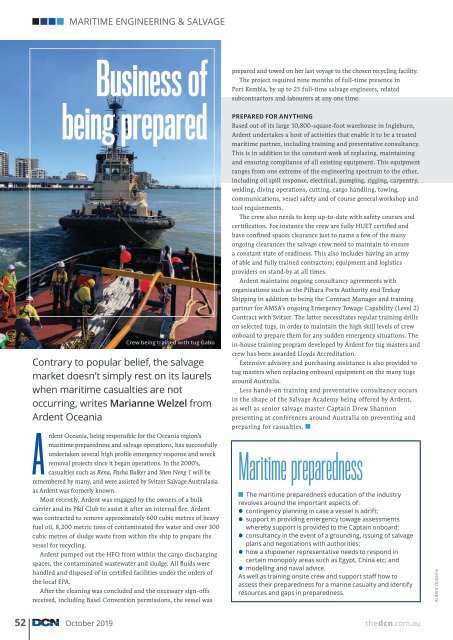DCN October Edition 2019
Create successful ePaper yourself
Turn your PDF publications into a flip-book with our unique Google optimized e-Paper software.
MARITIME ENGINEERING & SALVAGE<br />
Business of<br />
being prepared<br />
Crew being trained with tug Gabo<br />
Contrary to popular belief, the salvage<br />
market doesn’t simply rest on its laurels<br />
when maritime casualties are not<br />
occurring, writes Marianne Welzel from<br />
Ardent Oceania<br />
Ardent Oceania, being responsible for the Oceania region’s<br />
maritime preparedness and salvage operations, has successfully<br />
undertaken several high profile emergency response and wreck<br />
removal projects since it began operations. In the 2000’s,<br />
casualties such as Rena, Pasha Bulker and Shen Neng 1 will be<br />
remembered by many, and were assisted by Svitzer Salvage Australasia<br />
as Ardent was formerly known.<br />
Most recently, Ardent was engaged by the owners of a bulk<br />
carrier and its P&I Club to assist it after an internal fire. Ardent<br />
was contracted to remove approximately 600 cubic metres of heavy<br />
fuel oil, 8,200 metric tons of contaminated fire water and over 300<br />
cubic metres of sludge waste from within the ship to prepare the<br />
vessel for recycling.<br />
Ardent pumped out the HFO from within the cargo discharging<br />
spaces, the contaminated wastewater and sludge. All fluids were<br />
handled and disposed of in certified facilities under the orders of<br />
the local EPA.<br />
After the cleaning was concluded and the necessary sign-offs<br />
received, including Basel Convention permissions, the vessel was<br />
prepared and towed on her last voyage to the chosen recycling facility.<br />
The project required nine months of full-time presence in<br />
Port Kembla, by up to 25 full-time salvage engineers, related<br />
subcontractors and labourers at any one time.<br />
PREPARED FOR ANYTHING<br />
Based out of its large 10,800-square-foot warehouse in Ingleburn,<br />
Ardent undertakes a host of activities that enable it to be a trusted<br />
maritime partner, including training and preventative consultancy.<br />
This is in addition to the constant work of replacing, maintaining<br />
and ensuring compliance of all existing equipment. This equipment<br />
ranges from one extreme of the engineering spectrum to the other,<br />
including oil spill response, electrical, pumping, rigging, carpentry,<br />
welding, diving operations, cutting, cargo handling, towing,<br />
communications, vessel safety and of course general workshop and<br />
tool requirements.<br />
The crew also needs to keep up-to-date with safety courses and<br />
certification. For instance the crew are fully HUET certified and<br />
have confined spaces clearance just to name a few of the many<br />
ongoing clearances the salvage crew need to maintain to ensure<br />
a constant state of readiness. This also includes having an army<br />
of able and fully trained contractors; equipment and logistics<br />
providers on stand-by at all times.<br />
Ardent maintains ongoing consultancy agreements with<br />
organisations such as the Pilbara Ports Authority and Teekay<br />
Shipping in addition to being the Contract Manager and training<br />
partner for AMSA’s ongoing Emergency Towage Capability (Level 2)<br />
Contract with Svitzer. The latter necessitates regular training drills<br />
on selected tugs, in order to maintain the high skill levels of crew<br />
onboard to prepare them for any sudden emergency situations. The<br />
in-house training program developed by Ardent for tug masters and<br />
crew has been awarded Lloyds Accreditation.<br />
Extensive advisory and purchasing assistance is also provided to<br />
tug masters when replacing onboard equipment on the many tugs<br />
around Australia.<br />
Less hands-on training and preventative consultancy occurs<br />
in the shape of the Salvage Academy being offered by Ardent,<br />
as well as senior salvage master Captain Drew Shannon<br />
presenting at conferences around Australia on preventing and<br />
preparing for casualties.<br />
Maritime preparedness<br />
The maritime preparedness education of the industry<br />
revolves around the important aspects of:<br />
contingency planning in case a vessel is adrift;<br />
• support in providing emergency towage assessments<br />
whereby support is provided to the Captain onboard;<br />
• consultancy in the event of a grounding, issuing of salvage<br />
plans and negotiations with authorities;<br />
• how a shipowner representative needs to respond in<br />
certain monopoly areas such as Egypt, China etc; and<br />
• modelling and naval advice.<br />
As well as training onsite crew and support staff how to<br />
assess their preparedness for a marine casualty and identify<br />
resources and gaps in preparedness.<br />
Ardent Oceania<br />
52 <strong>October</strong> <strong>2019</strong><br />
thedcn.com.au
















